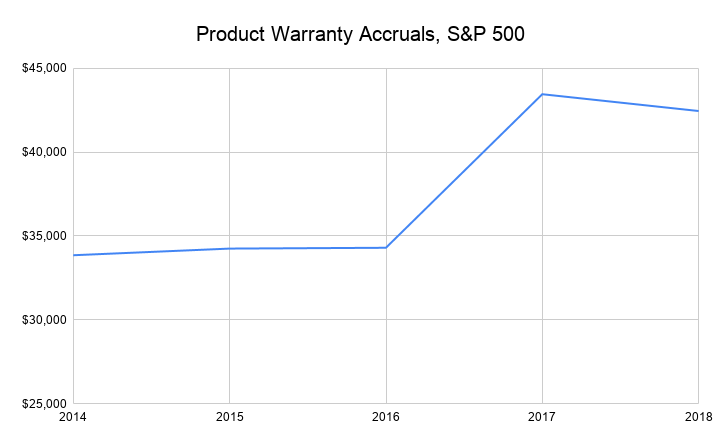Calcbench prides itself on tracking hard-to-find corporate data, and today we want to explore one niche of corporate reporting that’s always been one of our favorites: product warranty accounting.
A product warranty is a promise that a firm makes to its customers, that the firm will repair certain types of damage or even replace the whole product for a set number of days after sale. As such, companies need to accrue money to cover the cost of those warranties and list those accruals as liabilities (since they represent an obligation the company will eventually need to pay).
Moreover, the company also needs to record those accruals in the same period that the sales are made, so investors can get a better picture of the company’s true financial performance. Otherwise investors might see sales revenue rolling along quarter after quarter, and then suddenly depressed earnings when those warranty claims are finally processed months after initial sale.
We decided to play around with product warranty accruals among the S&P 500 for the last few years. Not many companies actually report these numbers; we found only 83 that reported accruals every year, 2014 through 2018. You can see the totals in Figure 1, below.

As you can see, total accruals jumped 25.4 percent over the last five years, from $33.85 billion in 2014 to $42.45 billion in 2018.
At a high level, one can argue that upward spike is a good thing. More warranty accruals means firms are selling more goods, to which those warranties are attached. Also, General Motors ($GM) accounts for a big portion of these numbers. For example, GM reported $15.2 billion in accruals in 2018, and $16.7 billion in 2017. Strip GM out of the sample, and total warranty accruals only rose 9.1 percent, from $25 billion five years ago to $27.27 billion last year.
We also did a company-by-company look at which firms had the largest increases in accruals, excluding GM. They were:
- Dentsply Sirona, 225 percent
- D.R. Horton, 207.4 percent
- Lennar Corp., 175.3 percent
- Align Technology, 171.6 percent
- IPG Photonics, 166.8 percent
Of course, many other factors can drive a firm’s warranty accruals beyond gross sales. The company might change its warranty policy to offer fewer of them, or start selling more products that don’t come with warranties. Management might also decide to change its estimates for how many products might get returned, which would therefore change the accruals.
Calcbench users can get a better sense of those factors by examining warranty items in our Interactive Disclosure viewer. Lennar Corp. ($LEN) is a good example here.
Nominally, Lennar had a huge increase in warranty accruals; see that 175.3 percent increase, above. In the footnotes, however, we see that acquisitions in 2018 drove a lot of that growth, as Lennar assumed responsibility for those warranties issued by the acquired businesses. See Figure 2, below.

You can indeed find details like that, either in the Interactive Disclosure tool or in our Multi-Company page, where you can search a bundle of standard metrics related to product warranties. Those metrics include new warrants issued, additions to warranties due to acquisitions, warranty payments, and more.
You can also read our User Guide for product warranties and guarantees for more information, including visual examples and more detail on exactly how we track this data.
That concludes today’s deep dive into an obscure niche of hard-to-find financial data. We love this stuff, so expect more dives in the future!